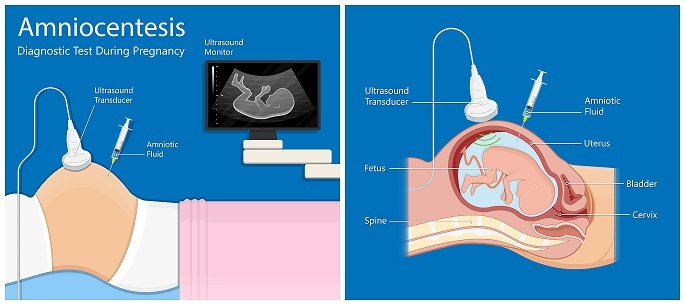
 Data Structure
Data Structure Networking
Networking RDBMS
RDBMS Operating System
Operating System Java
Java MS Excel
MS Excel iOS
iOS HTML
HTML CSS
CSS Android
Android Python
Python C Programming
C Programming C++
C++ C#
C# MongoDB
MongoDB MySQL
MySQL Javascript
Javascript PHP
PHP
- Selected Reading
- UPSC IAS Exams Notes
- Developer's Best Practices
- Questions and Answers
- Effective Resume Writing
- HR Interview Questions
- Computer Glossary
- Who is Who
What is Amniotic Fluid?
Introduction
Amniotic fluid is a clear, slightly yellowish liquid that surrounds the developing fetus in the uterus during pregnancy. It plays a crucial role in fetal development and protection, and any abnormalities in its production or composition can have significant consequences for the developing fetus.
The amniotic fluid is produced by the fetal kidneys and lungs, as well as by the placenta, and is continually replenished throughout pregnancy. It serves several important functions, including providing a cushion for the fetus, allowing for fetal movement and development, and regulating the temperature and pressure within the uterus.

One of the primary functions of amniotic fluid is to protect the developing fetus from physical trauma. It acts as a cushion, absorbing any impact or pressure that might otherwise harm the fetus. This is especially important during labor and delivery, when the fetus may be subjected to significant forces as it moves through the birth canal.
Another important function of amniotic fluid is to allow for fetal movement and development. As the fetus grows and develops, it needs room to move and stretch in order to develop properly. Amniotic fluid provides this space, allowing the fetus to move freely within the uterus.
Amniotic fluid also plays a role in regulating the temperature and pressure within the uterus. It helps to maintain a constant temperature, ensuring that the fetus does not get too hot or too cold. It also helps to maintain a constant pressure, which is important for the proper development of the fetal lungs.
In addition to these functions, amniotic fluid also contains a variety of nutrients and hormones that are essential for fetal development. These include proteins, lipids, carbohydrates, electrolytes, and growth factors, among others. These nutrients are absorbed by the fetus through the lungs and digestive system, helping to support its growth and development.
The composition of amniotic fluid can also provide important information about the health of the developing fetus. Abnormalities in the levels of certain substances, such as glucose, bilirubin, or alpha-fetoprotein, can indicate the presence of certain fetal abnormalities or conditions, such as gestational diabetes, hemolytic disease of the newborn, or neural tube defects.
The amount of amniotic fluid present can also provide important diagnostic information. Too little amniotic fluid, a condition known as oligohydramnios, can be a sign of fetal growth restriction or other fetal abnormalities, while too much amniotic fluid, a condition known as polyhydramnios, can be a sign of fetal distress or other complications.
There are several ways in which the level and composition of amniotic fluid can be measured. One common method is using ultrasound, which can provide a visual image of the amount of fluid present and can also be used to measure the diameter of the largest pocket of fluid. Another method is through the use of amniocentesis, in which a small sample of amniotic fluid is withdrawn from the uterus and analyzed for various substances and characteristics.
In some cases, medical intervention may be necessary to correct abnormalities in the level or composition of amniotic fluid. For example, in cases of oligohydramnios, the use of amnioinfusion, in which saline solution is infused into the uterus, may be used to increase the amount of fluid present. In cases of polyhydramnios, the use of medication or drainage may be necessary to decrease the amount of fluid present and reduce the risk of complications.
Overall, amniotic fluid plays a vital role in fetal development and protection. Its production and composition are carefully regulated throughout pregnancy, and any abnormalities can have significant consequences for the developing fetus. By monitoring the level and composition of amniotic fluid, healthcare providers can help to ensure the health and well-being of both the mother and the
Conclusion
Amniotic fluid is a vital component of fetal development and protection during pregnancy. It serves several crucial functions, including providing a cushion for the fetus, allowing for fetal movement and development, and regulating the temperature and pressure within the uterus. The composition of amniotic fluid can also provide important diagnostic information, allowing healthcare providers to identify potential fetal abnormalities and intervene as necessary. By monitoring the level and composition of amniotic fluid throughout pregnancy, healthcare providers can help to ensure the health and well-being of both the mother and the developing fetus.
FAQs
Q1. What causes low levels of amniotic fluid?
Ans. Low levels of amniotic fluid, known as oligohydramnios, can be caused by a variety of factors, including fetal growth restriction, premature rupture of the membranes, certain medications, and certain fetal abnormalities.
Q2. What causes high levels of amniotic fluid?
Ans. High levels of amniotic fluid, known as polyhydramnios, can be caused by a variety of factors, including fetal distress, fetal anomalies, gestational diabetes, and twin-to-twin transfusion syndrome.
Q3. Can amniotic fluid be replenished during pregnancy?
Ans. Yes, amniotic fluid is continually replenished throughout pregnancy. It is produced by the fetal kidneys and lungs, as well as by the placenta.
Q4. How is the level of amniotic fluid measured?
Ans. The level of amniotic fluid can be measured using ultrasound, which provides a visual image of the amount of fluid present and can also be used to measure the diameter of the largest pocket of fluid.

